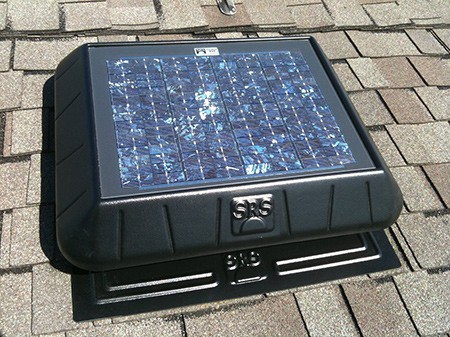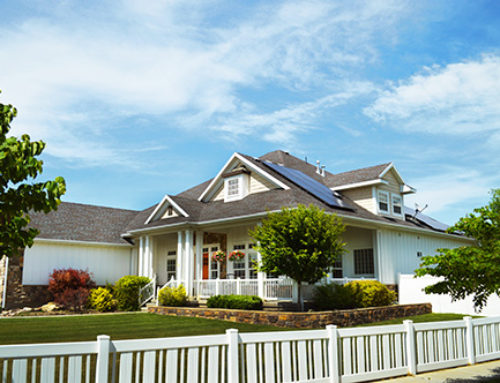A home energy system equipped with solar roof vents can cut energy costs by 30 percent.

These economical, environmentally-friendly devices are a smart way to keep attic temperatures from becoming too extreme. They are solar-powered (using energy directly from the sun) and get the job done year-round.
What is the secret? Solar roof vents are an energy-efficient way to solve home energy challenges. A solar vent allows for hassle-free attic venting. But what are they? How do they work? And why should you have them on your roof?
This article will discuss what solar roof vents are, why they are important, how solar roof vents work, and everything else homeowners should know about solar roof vents.

What are Solar Roof Vents and How Do They Work?
No matter how many square feet of attic space you have, airflow is essential during the year’s cold and hot times. That’s because even in wintertime, heat rises and fills attics, causing roof surfaces to heat up.
Why is a hot attic such a danger during the winter? Warm roofs melt snow and can cause it to turn into solid ice sheets on the side of your house. That’s bad for paint, siding, wood, metal, whatever covers the exterior of your home.
Attic vents to the rescue! An attic that is properly ventilated defeats the dreaded heat buildup that leads to so many problems. One of the main problems of over-heated attics is excessive energy bills.
When attic heat rises, it makes your air conditioner system run more often than it should, which leads to higher utility bills. But with proper attic insulation, warm air has somewhere to go.

The Advantages of Having Solar-Powered Roof Vents
How does a solar attic vent, as opposed to a simple attic fan or static vents, help solve your home’s energy imbalance and create ideal airflow?
Solar-powered vents for roof solutions have many advantages. For one thing, they run year-round, powered by sunlight. They help maintain the attic temperature at a lower level. That means air conditioners won’t get over-stressed trying to cool your home.
A cooler attic is also good for a home’s shingles’ health and adds to their life span. Most types of shingles, including solar shingles, can benefit from better ventilation. In fact, one of the key advantages of roof vents powered by solar electricity is that the moisture in your attic won’t build up to the point of damaging wood and other interior components.

What Homeowners Should Know About Vents

1. Vents with no moving parts:
Static vents have no moving parts and, while quite cheap, cannot get rid of dangerous hot air inside the typical attic.

2. Winter problems:
Winter is when moist air congregates in poorly ventilated attics. This can result in other problems later in the year. Hot summer air builds up and stresses the cooling power of the AC unit.
Winter problems with poorly ventilated attics include warped wood, mold buildup, and other structural problems due to high temperatures and high humidity.

3. Summer stress:
A poorly ventilated attic means your home essentially has a giant hot-box sitting on top of it during the summer. That’s not what you want when you’re already paying dearly for the AC system to keep the lower floors of your home cool.

4. Insulation issues:
Attics vents work best when a home is properly insulated. Otherwise, all the vents’ work to stabilize temperatures within an attic are for nothing. Good insulation keeps hot and cold air where it should be and lets the vents do their job more efficiently. Have a professional check the status of our insulation at least once per year.

5. Pests:
Homeowners often overlook the problem of pests when discussing attic vents. When attic spaces get too moldy, warm, and moist, they become magnets for squirrels, insects, and other unwanted animal kingdom members. With solar-powered vents in the roofs, well-ventilated homes prevent heat buildup and never become a haven for pests.

6. Solar vents for roof placement:
Solar-powered vents pay for themselves in the long run by reducing energy costs. They don’t even need to be bundled with other solar equipment to work (such as a solar battery charger, which is better for charging small devices).

7. In and out:
A proper attic ventilation system includes both intake and exhaust vents. There’s no point in having one without the other. When excess hot air is moved out of the attic space, there needs to be an avenue for cooler, drier outside air to move in.

8. Shop for the right kind of vent:
Based on the size of your home, the size and shape of your attic, the local climate, and your financial restraints, be sure to consider all ventilation options before your purchase a system. That’s the smartest way to ensure that you don’t end up with a mismatched attic ventilation system. With all the solar products out there, be sure to buy the correct solar powered roof vent before installing it.

9. Warranties:
One key area of comparison when shopping for a solar vent is the length of the warranty. Sometimes identical vents come with the same price by different warranties. When that’s the case, you’ll want to opt for a longer warranty.

10. Placement is essential:
The location of attic vents is a key part of their potential to get the job done. Make sure to get professional advice about exactly where to position solar-powered vents. Incorrect placement can almost completely nullify the vents’ ability to remove warm, moist air from your attic.
An electric attic fan can do the same thing solar-powered vents do but at a much greater cost. Depending on the square feet of attic space in a given home, solar attic vents can save homeowners as much as 30 percent on monthly utility bills. Static vents cannot move air out of your attic as quickly and efficiently as powered vents can.
When installing, watch for other products you may have, such as solar tubes, which allow natural lighting into your home. Be careful with any changes that could reduce their effectiveness.
A solar roof vent is powered by the sun, energy-efficient, effective, and works for homes of all sizes and shapes. Homeowners should consider placing solar-powered vents in their attics to lower energy bills, lengthen the life of their roofs, and prevent mold and rot inside the attic. It makes sense to turn to solar vents for roof and attic solutions.
